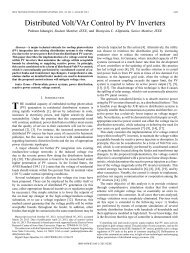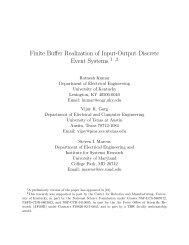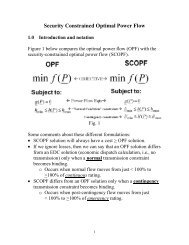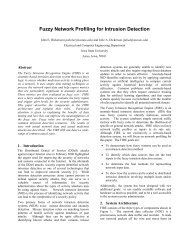Linearized Analysis of the Synchronous Machine for PSS Chapter 6 ...
Linearized Analysis of the Synchronous Machine for PSS Chapter 6 ...
Linearized Analysis of the Synchronous Machine for PSS Chapter 6 ...
Create successful ePaper yourself
Turn your PDF publications into a flip-book with our unique Google optimized e-Paper software.
ΔT<br />
exc<br />
=<br />
− K<br />
+<br />
3 5 A<br />
osc F<br />
( )( )( ) ( Δ δ )<br />
jω<br />
+ σ + jω<br />
jω<br />
+ σ + jω<br />
jω<br />
+ σ + jω<br />
osc<br />
1<br />
1<br />
2K<br />
K K ( 1<br />
osc<br />
2<br />
jω<br />
T<br />
2<br />
)<br />
osc<br />
3<br />
3<br />
On combining imaginary terms in <strong>the</strong> denominator, we get:<br />
− K2K3K5K<br />
A(<br />
1+<br />
jωoscTF<br />
)<br />
ΔTexc<br />
=<br />
σ1<br />
+ j( ω1<br />
+ ωosc<br />
) σ<br />
2<br />
+ j( ω2<br />
+ ωosc<br />
) σ<br />
3<br />
+ j( ω3<br />
+<br />
We are interested in <strong>the</strong> phase <strong>of</strong> ΔT exc relative to Δδ.<br />
( )( )( ) ( Δ δ ) ω )<br />
Fact: When <strong>the</strong> generator is heavily loaded, it is possible <strong>for</strong> K 5 to<br />
be negative. See Fig. 6.1and section 8.4.3 in your text. This makes<br />
<strong>the</strong> numerator <strong>of</strong> <strong>the</strong> previous transfer function positive.<br />
A simulation <strong>of</strong> such a case is shown in Fig. 8 below. The solid<br />
curve represents generators with fast high-gain excitation systems,<br />
but no <strong>PSS</strong>. The o<strong>the</strong>r two curves represent significantly fewer <strong>of</strong><br />
such generators.<br />
osc<br />
Fig. 8<br />
14
















